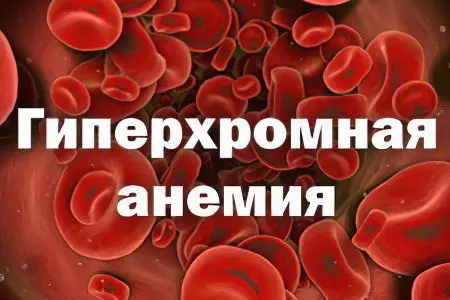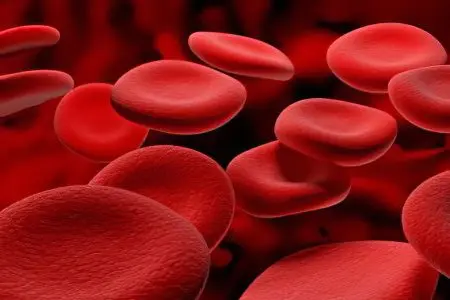Contents

Hyperchromic anemia is characterized by a decrease in the level of red blood cells and hemoglobin in the blood. The disease develops against the background of a violation of the work of the hematopoietic organs.
Depending on the cause that provoked the development of hyperchromic anemia, the following types of it are distinguished:
Megaloblastic anemia. The failure occurs at the level of DNA and RNA. Megaloblasts begin to form in the bone marrow. Myelodysplastic syndrome, HIV, and taking certain medications, such as Azathioprine, can provoke pathology.
Non-megaloblastic anemia. DNA in this case is synthesized as expected, but megaloblasts are not produced in the bone marrow. Liver pathologies, cancerous tumors, hypothyroidism, alcoholism, myeloproliferative diseases can lead to the development of this type of anemia.
At risk for the development of hyperchromic anemia are women and men over 40 years of age.
Symptoms of hyperchromic anemia

Symptoms that characterize hyperchromic anemia:
The skin and mucous membranes are pale. Some yellowness of the skin is possible.
Hair starts to gray prematurely.
The person gets tired faster.
The digestive system is dysfunctional.
The function of hematopoiesis suffers.
The tongue becomes painful.
The gums begin to bleed.
First of all, the patients themselves pay attention to changes in the language. In addition to the fact that he begins to get sick, his appearance suffers. The surface of the organ becomes unnaturally smooth and shiny. After a while, spots appear on it, which tend to merge. This gives the impression that the tongue has become bright red. The pain gets worse when you try to move your tongue. The taste buds of the body are dulled.
Symptoms of anemia may not bother a person. The only visible sign of the disease is often pale skin. In addition, the patient may notice a decrease in efficiency, the appearance of heart pain and disturbances in the functioning of the digestive system.
As the disease progresses, these symptoms begin to intensify.
Therefore, it is advisable to divide them into 3 large groups:
Change in skin color. Besides the fact that they become pale, sometimes a person may notice their slight yellowness. This also includes intermittent tinnitus and increased shortness of breath. It is against its background that a person most often experiences pain in the heart.
Digestive system disorders: change in taste preferences, loss of appetite, feeling of heaviness in the epigastric region, diarrhea. The liver increases in size, the tongue becomes a bright color.
Changes in the hematopoietic system: the level of red blood cells falls, their shape and structure are disturbed. In addition, the patient is diagnosed with moderate leukopenia.
Sometimes the patient complains of a feeling of numbness of the extremities.
Hyperchromic anemia and myelodysplastic syndrome
Hyperchromic anemia can be combined with myelodysplastic syndrome. It contributes to its development exposure to radiation, the passage of chemotherapy to get rid of tumor neoplasms, the treatment of leukemia.
As a result, the red bone marrow becomes unable to perform its functions in full. Symptoms indicating myelodysplastic syndrome are: tachycardia, frequent dizziness, shortness of breath against the background of physical rest. To diagnose this disorder, you must consult a doctor and undergo laboratory tests.
Causes of the development of hyperchromic anemia

Hyperchromic anemia rarely develops in young people. Elderly people are more susceptible to it.
The following conditions lead to hyperchromic anemia:
Vitamin B12 deficiency.
Folic acid deficiency.
myelodysplastic syndrome.
The main risk factor for developing hyperchromic anemia is a lack of vitamin B12. Causes of B12 deficiency anemia include:
atrophic gastritis. With this disease, an insufficient amount of gastromucoprotein is produced in the body, which prevents vitamin B12 from being fully absorbed.
Diseases of the small and large intestines, in which their walls are damaged.
Intestinal diseases of an infectious nature.
Worm invasions.
Also, a lack of folic acid can lead to hyperchromic anemia. A similar problem often develops with alcoholism, as well as in people suffering from viral hepatitis. Sometimes folate deficiency anemia can manifest during pregnancy and when the principles of a healthy diet are not followed.
DNA production has a direct relationship with folate and vitamin B12. With their deficiency, this important biological process stops. The division of erythroblasts slows down, as a result of which they transform into megaloblasts.

Treatment

If there is no treatment for hyperchromic anemia, the disease will progress. This can lead to serious consequences, up to coma and death. Therefore, you need to contact a specialist as soon as possible.
The treatment will be long, it is necessary to strictly adhere to the therapeutic regimen. Often, the patient is prescribed a course of medication. This will avoid recurrence of the disease and prolong remission. In severe cases, a bone marrow transplant is required.
Mild anemia can be eliminated with a balanced diet. The menu must include meat products and animal liver.
Cyanocobalamin is prescribed for B12 deficiency and folate deficiency anemia. The dose is selected by the doctor. If the treatment gives positive results, the dose is gradually reduced. In addition to treatment, the patient is prescribed folic acid. To understand whether the therapy is effective, the patient will need to regularly donate blood for analysis. If the level of reticulocytes in the blood rises, then the therapy was chosen correctly.
The effectiveness of treatment should be assessed after 7 days from its start. If there is no positive dynamics, then it is advisable to revise the therapeutic regimen.
In severe anemia, red blood cell transfusion is required. It is important to accurately determine the causes that led to the development of anemia before starting treatment.
Health effects
In childhood, hyperchromic anemia is dangerous due to a delay in mental and physical development. The child will be more susceptible to various diseases, his immunity is not able to cope with infections. Such children get sick for a long time and hard.
Anemia is dangerous for pregnant women who may begin premature birth. The fetus will suffer from a lack of nutrients, the child may be born with underweight and developmental anomalies. Therefore, during pregnancy, you need to regularly visit an obstetrician-gynecologist.
Other consequences of anemia include: cardiomyopathy, tachycardia, heart failure. Therefore, the treatment of this disorder should be timely.









